We’ve got a new family member at Oliveira do Paraíso! Meet Zambú, a tall, gorgeous Galgo gentleman. He joined our family last month, but we’ve kept him under wraps for a few weeks while he got settled in and used to us—and to his new name.
Before we adopted him, Zambú’s name was “Rambo,” which is a name that does not fit him in look, style, or personality. In Portuguese, “Rambo” sounds kind of like “Hahm-boo” so Marido, Filha and I brainstormed a whole raft of names that sounded similar but fit his vibe. We landed on Zambú (“zam-Boo”).
I’ve wanted a second dog for a very long time. Vila, our Boxer/Boston Terrier mix, has never met a dog she didn’t love. I knew shortly after we rescued her that she would be happiest with a live-in dog friend. But at the time Filha was a toddler and we lived in a small house in San Francisco. Marido and I both traveled a lot for work and it just seemed a bit much.
But now, well. Now we live in a large home on 3,000 sq. meters of land. There is plenty of room in the house for multiple dog beds and plenty of room outside for multiple romping doggos.
[Fair warning that this is a dog-centric post with a LOT of pet pics. If you’re reading this in your email it might get truncated, so to be sure you’re seeing everything, just click on the title to go through to the website.]
The right time; the right dog
Once our the last guests of summer flew back to the States in July, I ramped up the search for a dog. I knew just what kind of dog would fit in well with a slightly-allergic guy who cooks up large pots of homemade dog food; an animal-loving pre-teen who’s really good at belly rubs; a small, opinionated parrot who thinks she runs the show; a middle-aged, meatloaf-shaped napping champion (that’s Vila); and another middle-aged lady who’s really good at coming up with multiple animal nicknames (that’s me).
Back in Oakland, CA, my friend Michelle shares her home with two gorgeous Greyhounds, Fern & Pintxo. They were the first Greyhounds I got to know, and I thought they were delightful. Vila did too—although she’s always had a penchant for tall, handsome gentlemen because they make her feel petite.
When I knew we were moving to Portugal, I began researching to see if there were any Greyhound rescues in Europe. That’s how I came to learn about the Galgo. There is speculation that the English Greyhound—often used for racing in the States—is a descendant of the Spanish Galgo.
Both are sighthounds, and they look quite similar. But according to my research, Galgos are “higher in the rear than in the front, and have flatter muscling than a Greyhound, which is characteristic of endurance runners. They also tend to be smaller, lighter in build, have longer tails and have a very long, streamlined head that gives the impression of larger ears.”
Galgos and Greyhounds also share a similar temperament. They are generally calm, gentle and laid back; but can also be reserved and even shy. Though famous for their speed, they’re often called the 40mph couch potato because they are highly skilled nappers and really quite lazy around the house.
O Galgo Espanhol
The Galgo is an ancient breed. Some think their ancestors are Egyptian dogs that the Phoenicians brought to the Iberian Peninsula in the 10th century BC (3,000 years ago). For generations they were bred and raised by Spanish nobles and have long been used for hunting hares.
But Galgos are also some of the most abused dogs in the world. After age 2 or 3, they aren’t as fast as they used to be. And when a hunter deems a dog not fast enough, they are thrown out like trash or killed, often brutally.
«Trigger warning: The next couple of paragraphs talk about animal abuse. If that’s not something you want to read about, skip down below the next photo and continue reading.»
When I first read about this, I assumed the dogs were killed quickly. But I’ve since learned that some hunters throw dogs into wells where they drown or starve. Some hunters will “punish” a galgo for being too slow or for breaking their rules and will hang the dog from a tree with its back feet just barely touching the ground. It can take days for death to come.
This happens not just once or twice, but over and over again, to THOUSANDS of dogs, year after year. One rescue organization estimates that 60,000-80,000 Spanish hunting dogs—Galgos and Podencos—are dumped, abandoned, and killed at the end of each hunting season in February.
The stories are horrific. But, as is often the case when horrors lurk, there are helpers too.
Several organizations in Spain work tirelessly to rescue abandoned and abused hunting dogs. One such org is Galgos del Sol, who rescues not just Galgos, but Podencos—or Podengos, as they are known in Portugal. Galgos del Sol goes to great lengths to bring these dogs in off the streets (or gutters, garbage dumps, mountainsides, and underbrush), nurse them back to health, and find them happy homes all over the world.
I began following the org on Instagram in late 2020, and with each rescue story I watched, I grew even more determined that when the time was right, our family would give hope and a happy home to an abandoned Galgo.
A digression on animal welfare in Portugal
Shortly after moving to Setúbal in 2021, we met a wee Portuguese Podengo named Cody. His person, an older Dutch man, told us he adopted Cody from a local rescue called O Cantinho da Milu (Milu’s Corner).
Located along the A2 highway east of Setúbal, O Cantinho da Milu is home to more than 700 dogs.
That is not a typo. Seven Hundred dogs.
The dogs at Milu’s are all ages, sizes, breeds, and mixes. They have all kinds of stories—some were tearfully surrendered by owners who could no longer care for them; others have never known a loving human hand.
But all are given a second chance by a woman named Milu, who found an abandoned puppy in Lisbon 30 years ago and just never stopped rescuing dogs. Though her shelter now cares for a staggering number of dogs, from what I have seen they are all clean and well-cared for and loved on by a host of volunteers (and by Milu herself).
Dogs in Portugal—animals in Portugal—are not treated the same as we are used to in the States. This is a generalization, because of course most people in Portugal love their dogs, cats, parrots, iguanas, goats, donkeys, etc. There is also a law in Portugal which states: “All unjustified violence against animals is forbidden.” And yet.
In San Francisco, I had my pick of dozens of doggie daycares and spas and hotels and walkers and trainers and coddlers of all kinds. Pampering your pet has been elevated to an art form of sorts in the US. But this is also a generalization. Because people are people, all over the world, and some of those people treat animals with utter cruelty and disregard.
Some of what I have seen in Portugal, such as horses tied to stakes to graze in the middle of an unfenced field, is a cultural difference. In the US you’d never think to ask if your pony could come over and eat your neighbor’s grass whilst leaving piles of fertilizer all over the yard. But in Portugal, it seems to be common to take your horses, sheep, and other grazing animals out for a stroll to chow down on ditch grass—or to camp out in your neighbor’s field for a couple of weeks and eat everything down to the dirt.
Although I really do love the occasional sheep traffic jam, the practice of tying horses out in the field and leaving them largely unattended for days or weeks (except for water delivery) has been hard for this formerly horse-obsessed girl to get used to.
As has the sight of stray dogs wandering the city now and then—or not even stray dogs, but neighborhood dogs without a collar or owner in sight, pooping unbothered in the middle of the street.
There is more of a tendency here—especially out in the country—to view animals as seasonal tools or disposable possessions. Of course, this happens out in the country in the States, as well. And because the internet is the internet, I feel the need to state in no uncertain terms that I am not trying to characterize things in black-and-white, good-and-bad like: “In Portugal, animals are treated like shit and in the US, animals live like kings.” That is obviously false. I can repeat my earlier “bad people are everywhere” statement if you like.
The truth of my experience living in both countries is that culturally, animal welfare is simply a different story in each place.
Although there are laws are in place to protect animals in Portugal, according to a writer named Viriato Villas-Boas, the reality is that: “the country simply lacks the means and will to fully enforce said laws.” (Villas-Boas’ article on animal rights in Portugal is worth the read, if you’re interested.)
There are also unintended consequences to animal welfare laws, such as the one passed in 2018 that makes it illegal to kill an animal for population control. As Villas-Boas puts it, “if animals are not being euthanised, it is only a matter of simple maths to conclude that there will be an immediate increase in populations roaming the streets or housed in shelters/kennels (and even this logic excludes the added numbers of abandoned animals, or those who are taken into custody by the authorities for animal abuse).”
This is why O Cantinho da Milu is the only home most of its 700+ residents will ever know. There are simply more dogs available than people who want to give them a home. (And no, I am not in any way advocating for euthanasia of stray dogs.) Spaying and neutering pets is not a universal practice in Portugal, so there never seems to be a shortage of unwanted dogs (and cats).
Enter the long fellow from Spain
Since I wanted a Galgo to join our family, and I wanted to adopt that Galgo, visiting O Cantinho da Milu was the obvious choice. Lucky for us, they had two Galgos up for adoption, and one of them was a very tall gentleman named Rambo.
After finding Rambo/Zambú on their website and sending an email to inquire about him, I was asked to fill out an extremely thorough adoption application. It took me three hours to complete (I was extremely thorough, as well). I took the detailed application questions as a good sign that O Cantinho da Milu was serious about vetting potential adopters.
Filha and I visited Rambo/Zambú one dusty Saturday, and then returned the following Saturday with Vila in tow. This is a photo of their first meeting (and it’s pretty indicative of their ongoing relationship, as well):
The meeting was far more exciting for Vila, who is very invested in having a dog sibling/mate/friend, than for Zambú, who has always been surrounded by dogs, first in a hunting kennel in Badajoz, Spain and later with hundreds of canine companions at Milu’s.
We learned that Zambú was indeed used to hunt hares in Spain, and at the age of 6 was considered too old to continue his career. Luckily for him, his previous owner did not kill or discard him, but surrendered him to a rescue—along with his Spanish passport:
Zambú arrived in Portugal in December of 2021, with five other Galgos. By the time we met him, he had been at Milu’s rescue for 7 months. No one wanted to adopt him because, at nearly 7 years of age, he was “too old.”
We brought Zambú home on a Tuesday afternoon, three days after he met Vila.
Upon arrival, it was obvious he had never before been welcomed into a human’s home. He was mystified and curious about everything… the refrigerator, the table, the toilet, the dog bed. He had no idea what to make of any of it, and the first night he slept on the bare floor. By the second night, he had tested out (and quickly approved of) his memory foam mattress.
Within a week, he was taking naps like this:
I sent the photo to my friend Michelle (she of the Fern & Pintxo fame) and said, “This is a good sign, right?”
She wrote back right away: “So good! It means he’s happy and safe.”
It's called roaching, apparently, and it’s a thing greyhound and greyhound-adjacent dogs do—the sleeping with legs akimbo thing, not the gross dating thing (don’t google it).
Although at first he seemed to be constantly waiting for us to give him a job to do, Zambú soon began watching Vila for cues. He learned to follow her through the doggie door. He learned when meals happen and where we keep the dog treats.
Gradually, he began to figure out what “retirement” means, and that Vila, who is a few years his senior, has a strict 17-naps-a-day policy. (He has no problem with this.)
In the four weeks since he’s been with us, Zambú has expressed his fondness for squeaky toys, established a twice-a-day zoomies routine, snarfed down impressive quantities of Marido’s homemade dog food, become besties with Vila, and made it very clear that he’s NOT interested in eating FeeBea the parrot.
He’s also earned several nicknames: Senhor Zee, Zamboozle, ZimZam, Tall Sir, Longfellow, and Zambeezus. (Told you I was good at nicknames.)
O Cantinho da Milu requires adopters to wait four weeks to change the microchip registration over from the rescue to the new family. Just to make sure everything settles and everyone—dog and human—is happy.
Today, we’ve reached the four week mark and I messaged the rescue to say, “Please change that microchip reg, STAT!”
We are all utterly charmed and dazzled by our tall, sweet Spanish boy. No one so much as Vila, though. She is beyond delighted to have him here. For the first week, every time she woke up from a nap and saw that he was still here, she’d spin in ecstatic circles, box his legs with her paw and cover his muzzle in kisses, like, “You’re here! You’re STILL HERE!!!”
It’s clear that Zambú is family now. He’s here to stay for always.
But wait! There are even MORE dog photos…
Copyright © 2022 LaDonna Witmer

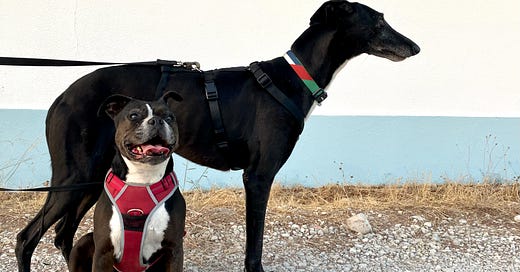


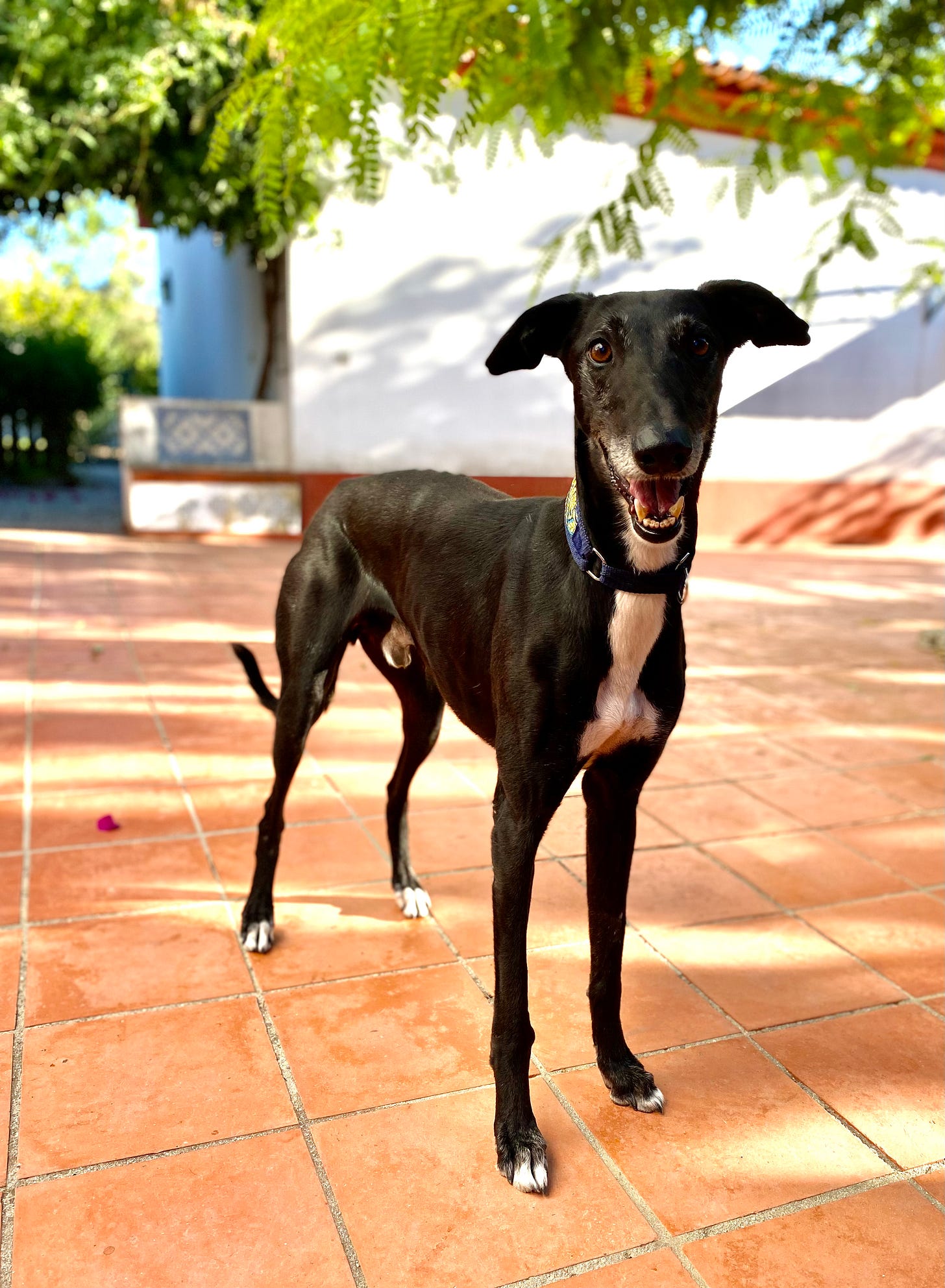

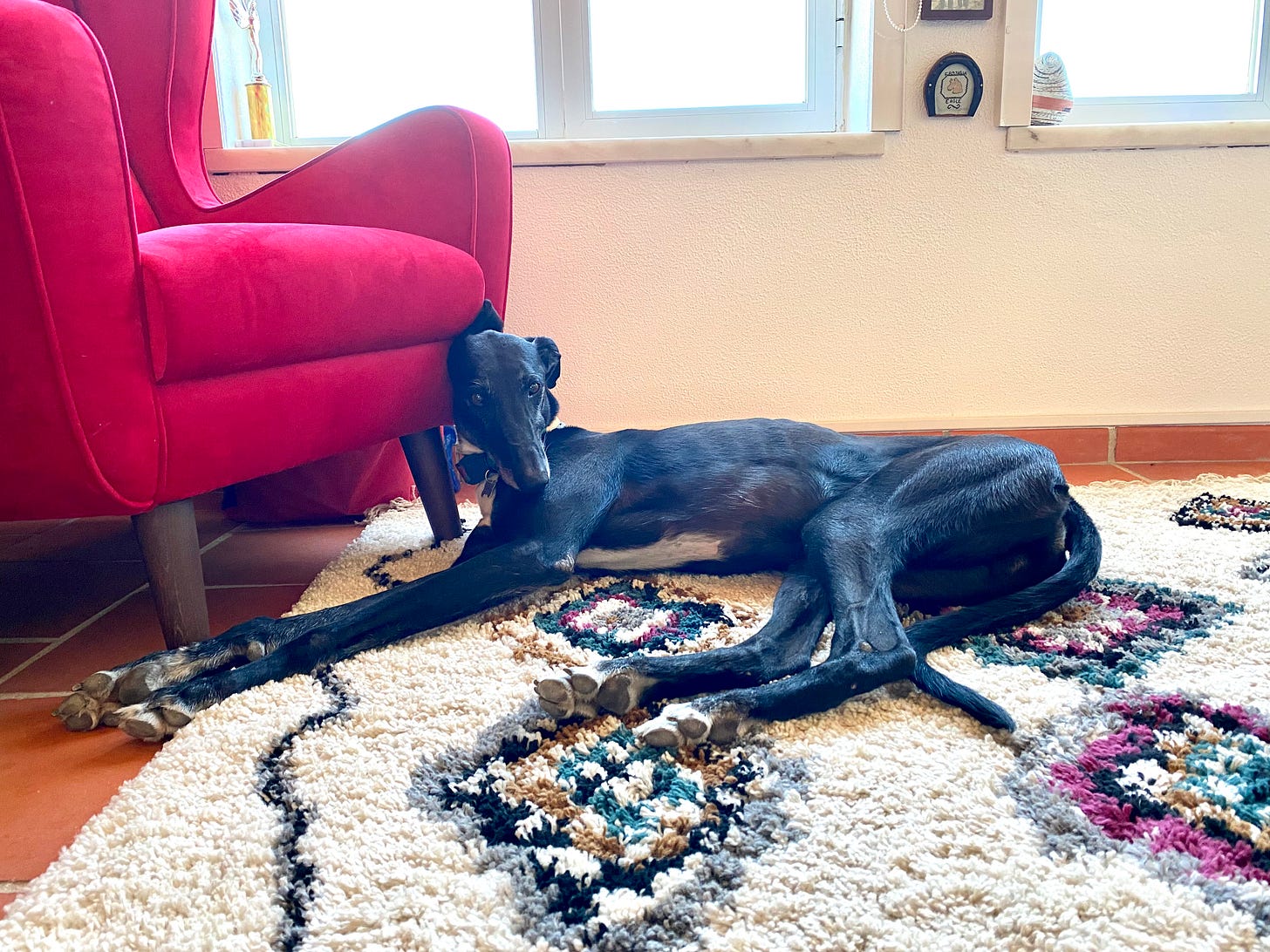
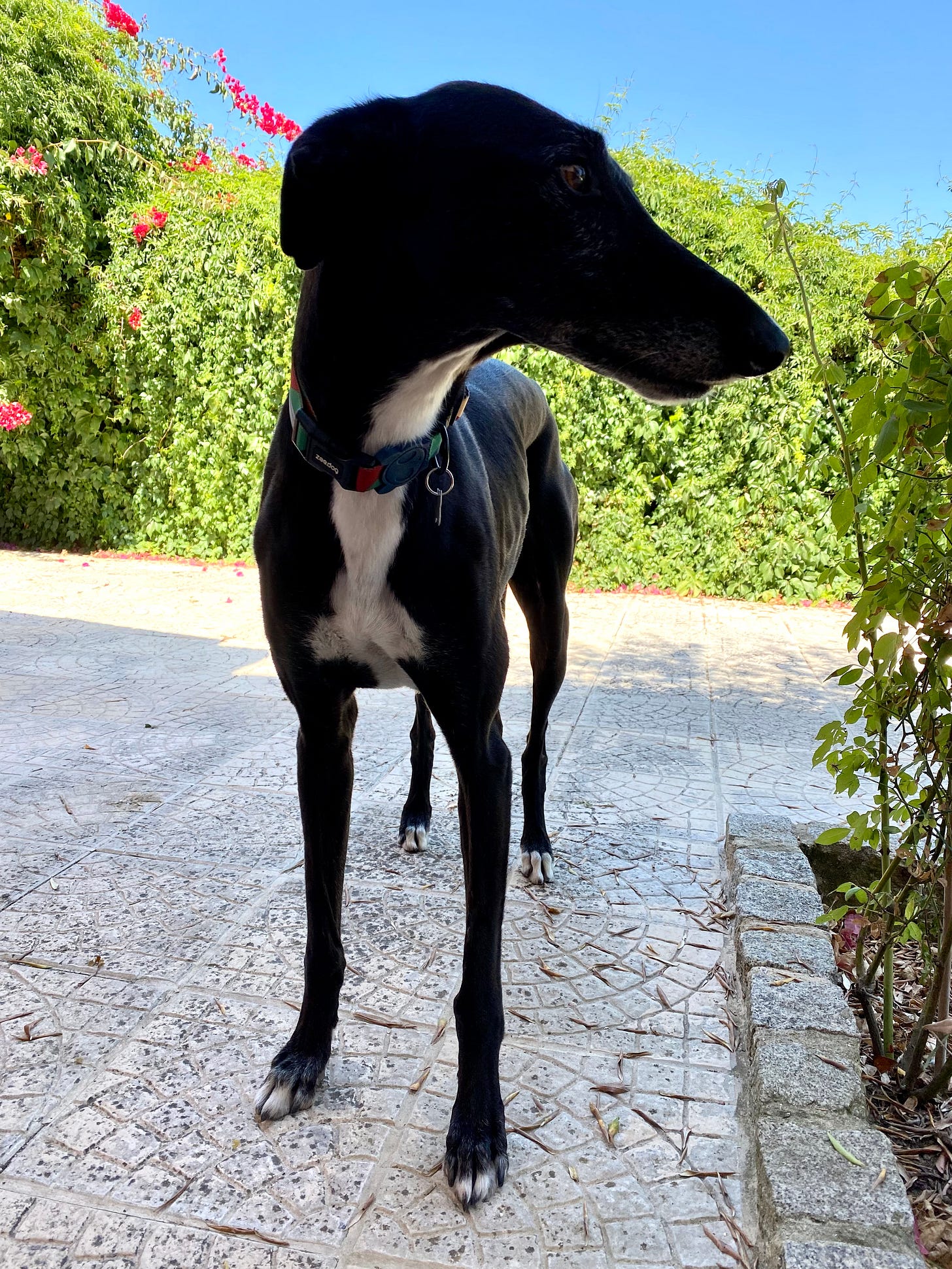
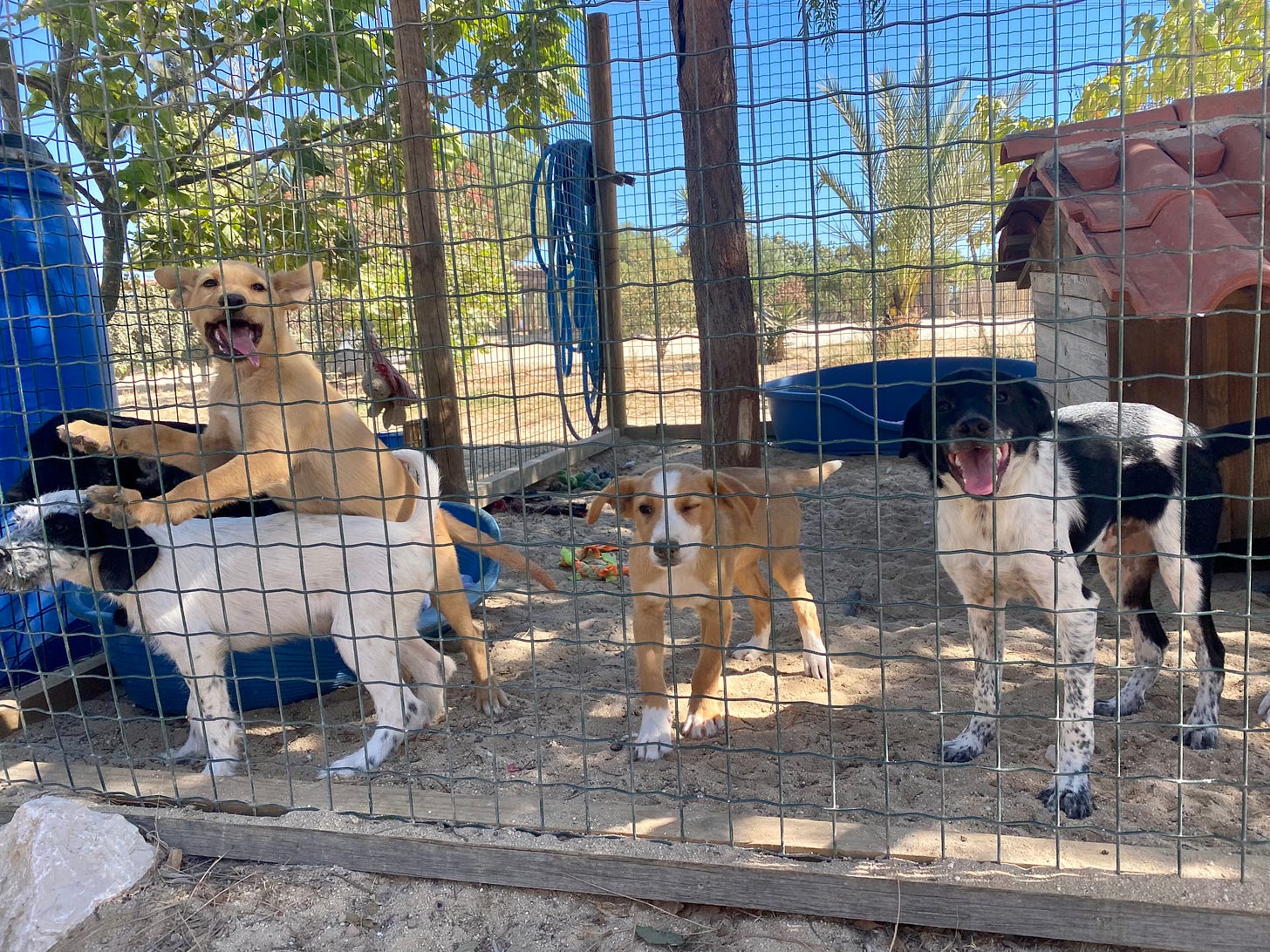
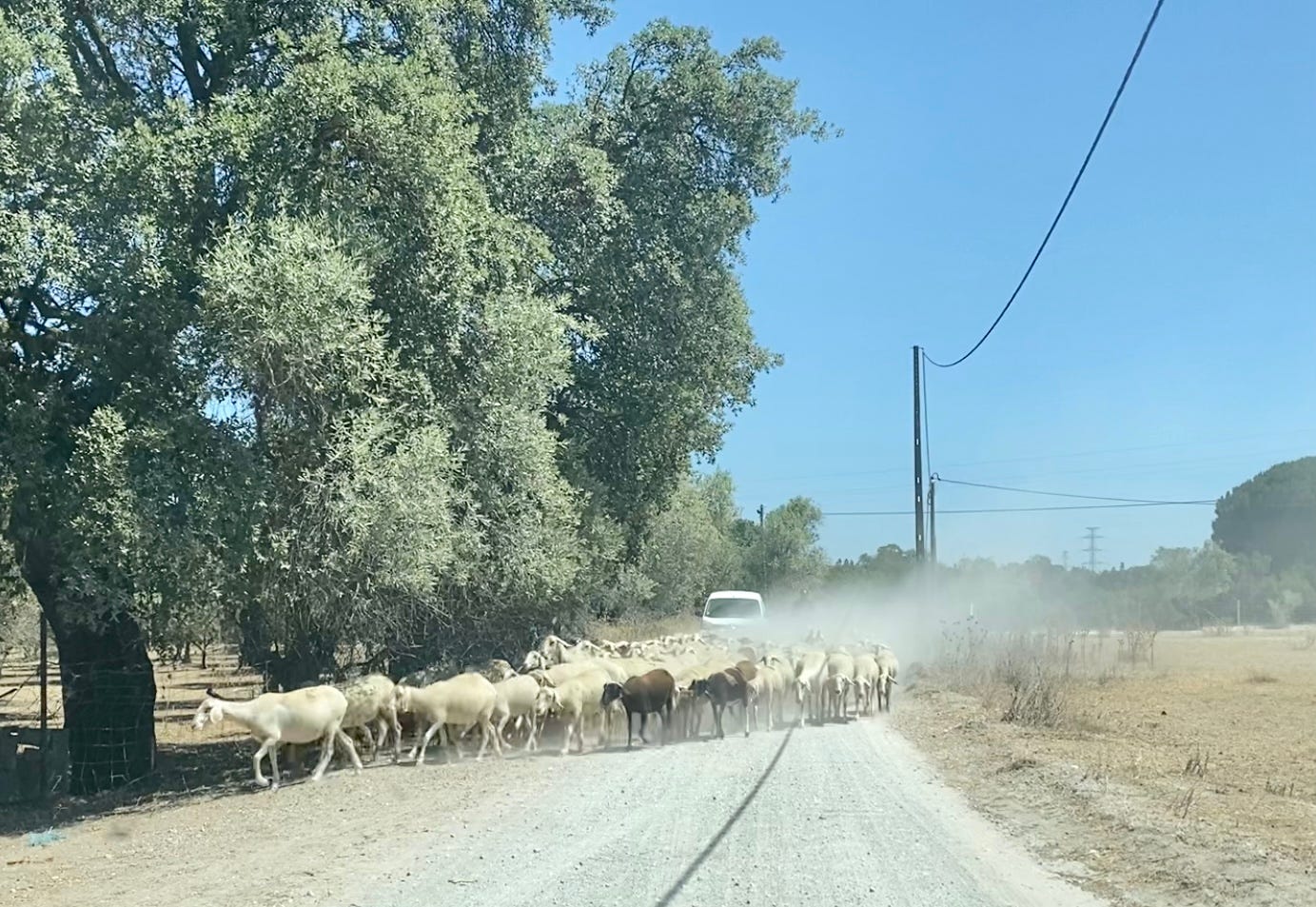
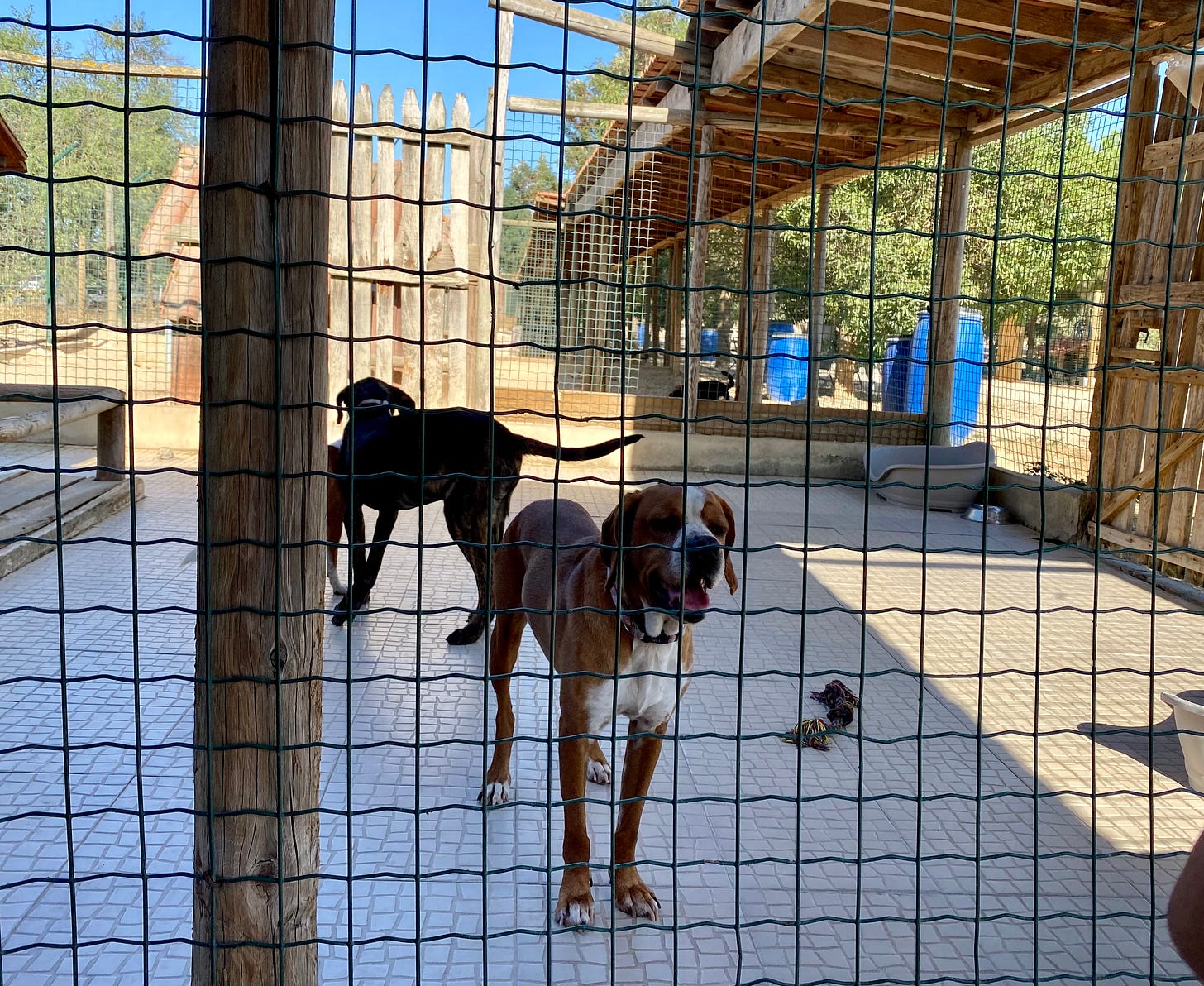

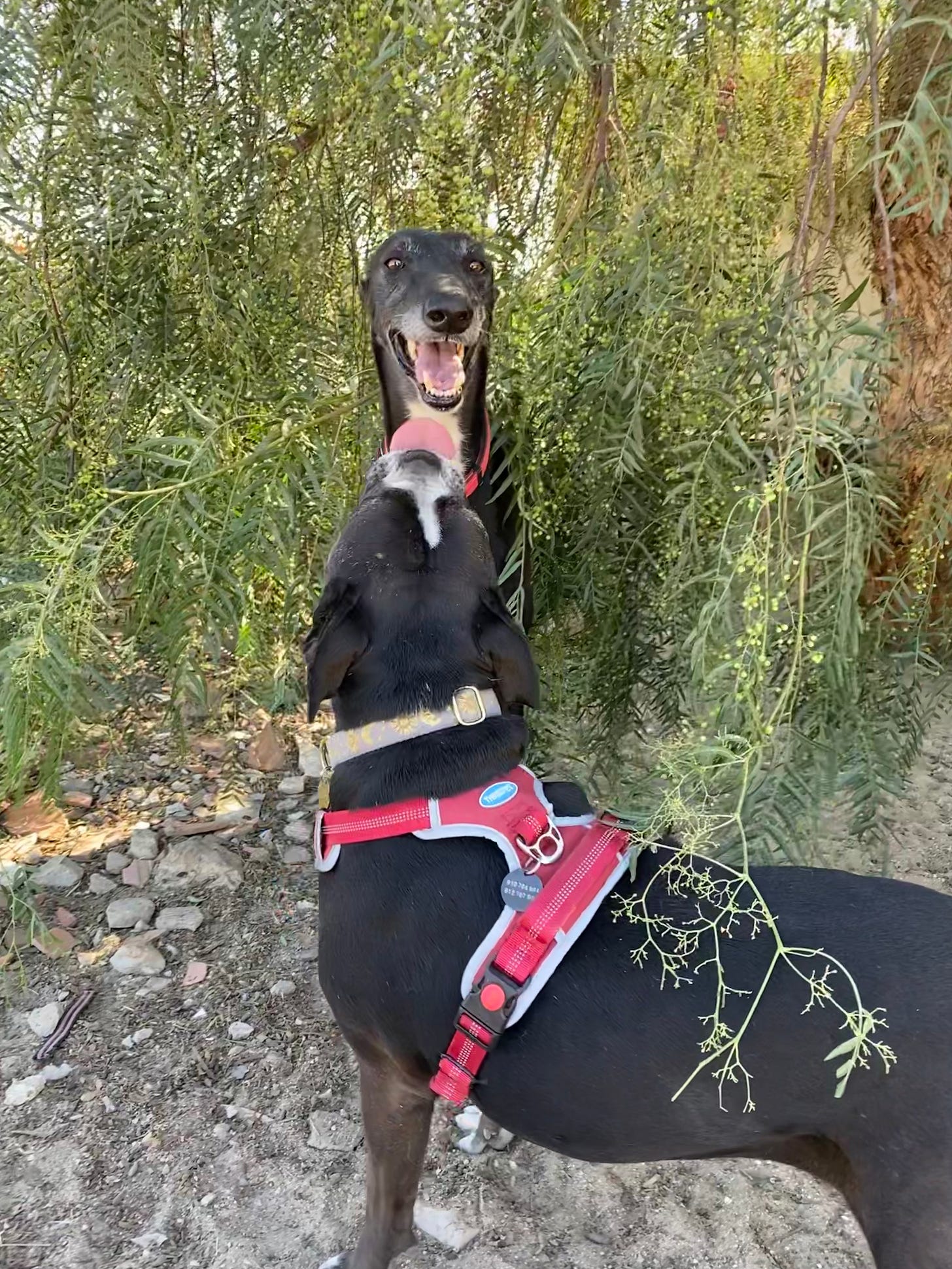
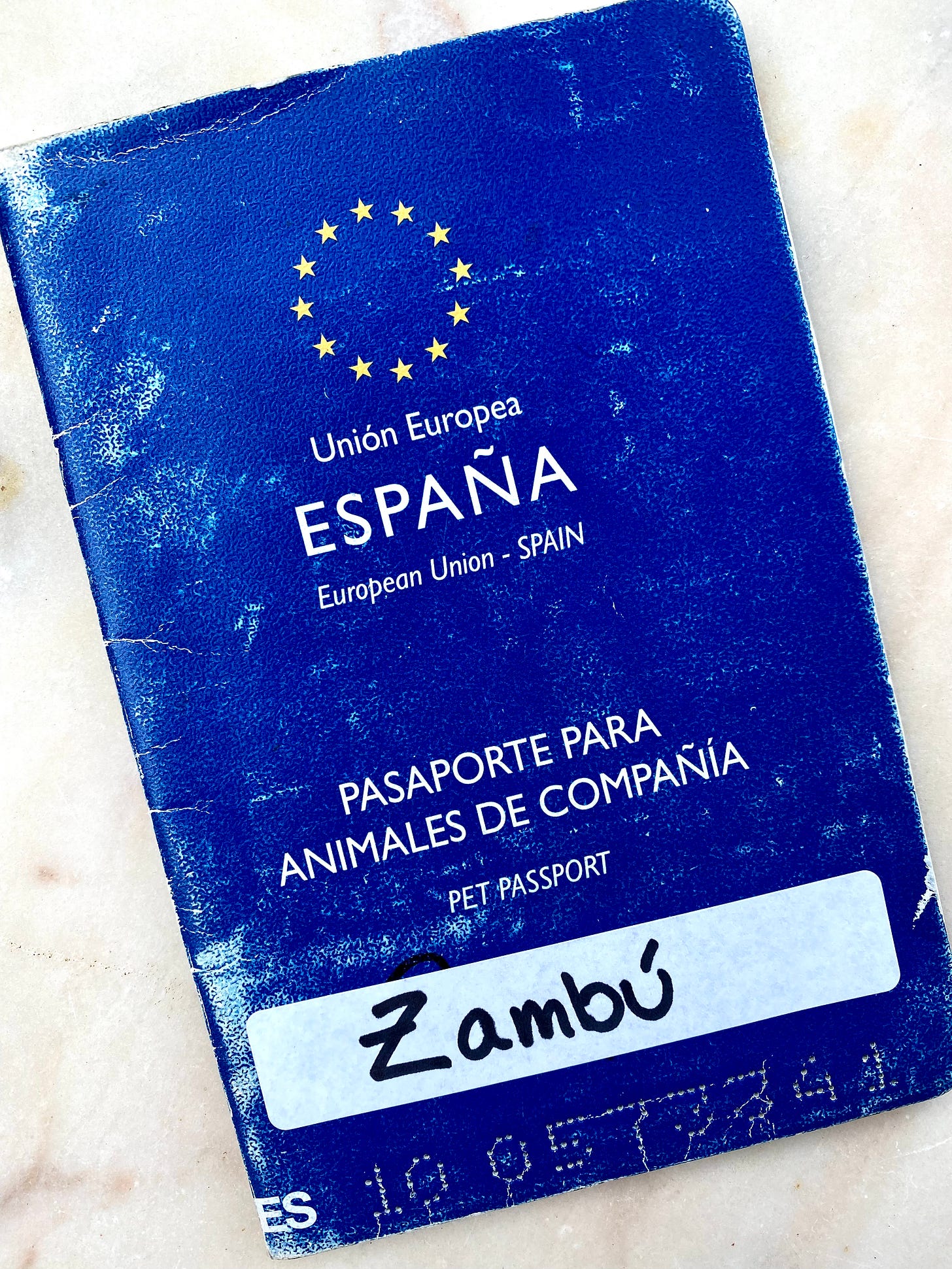
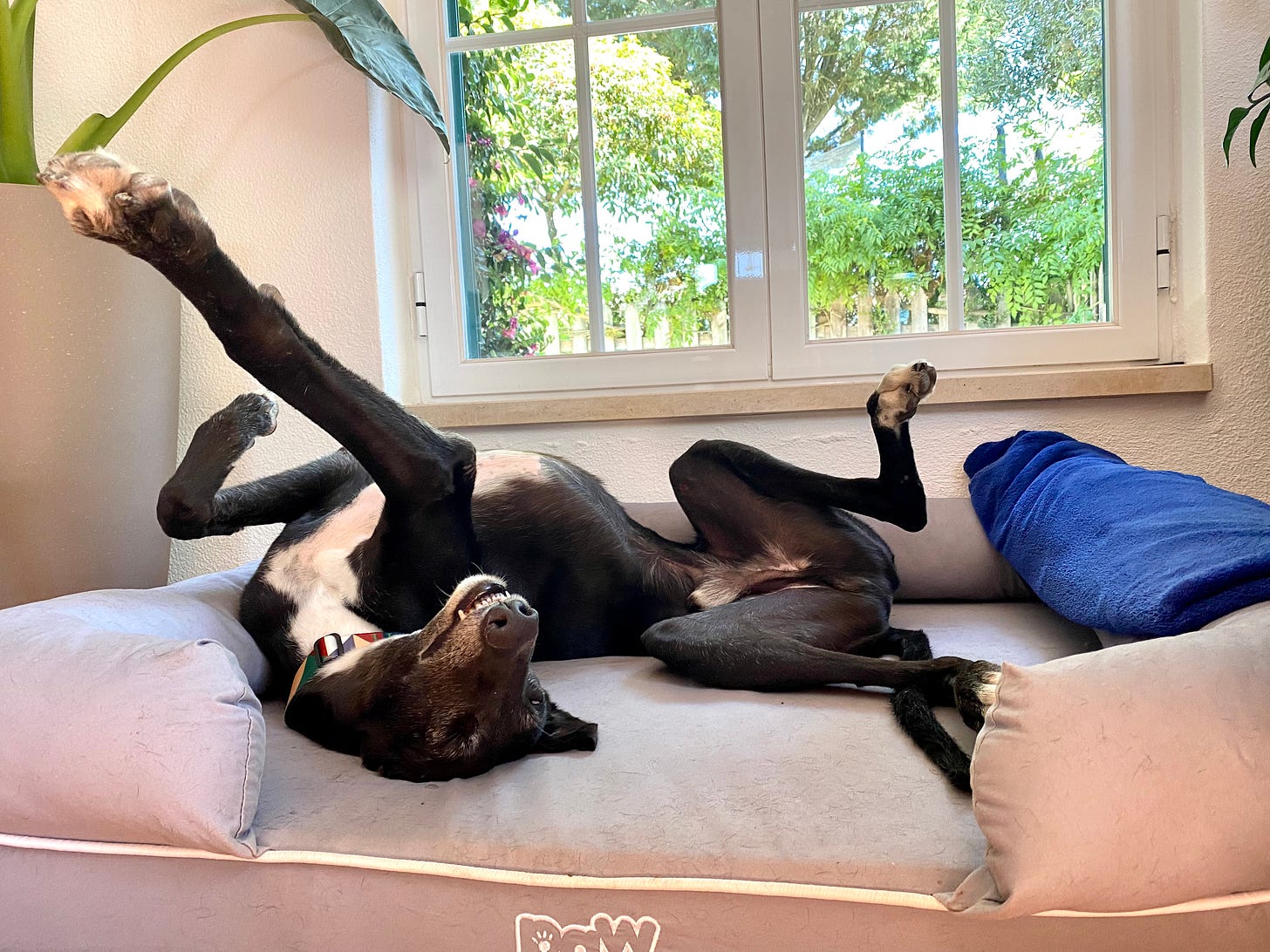

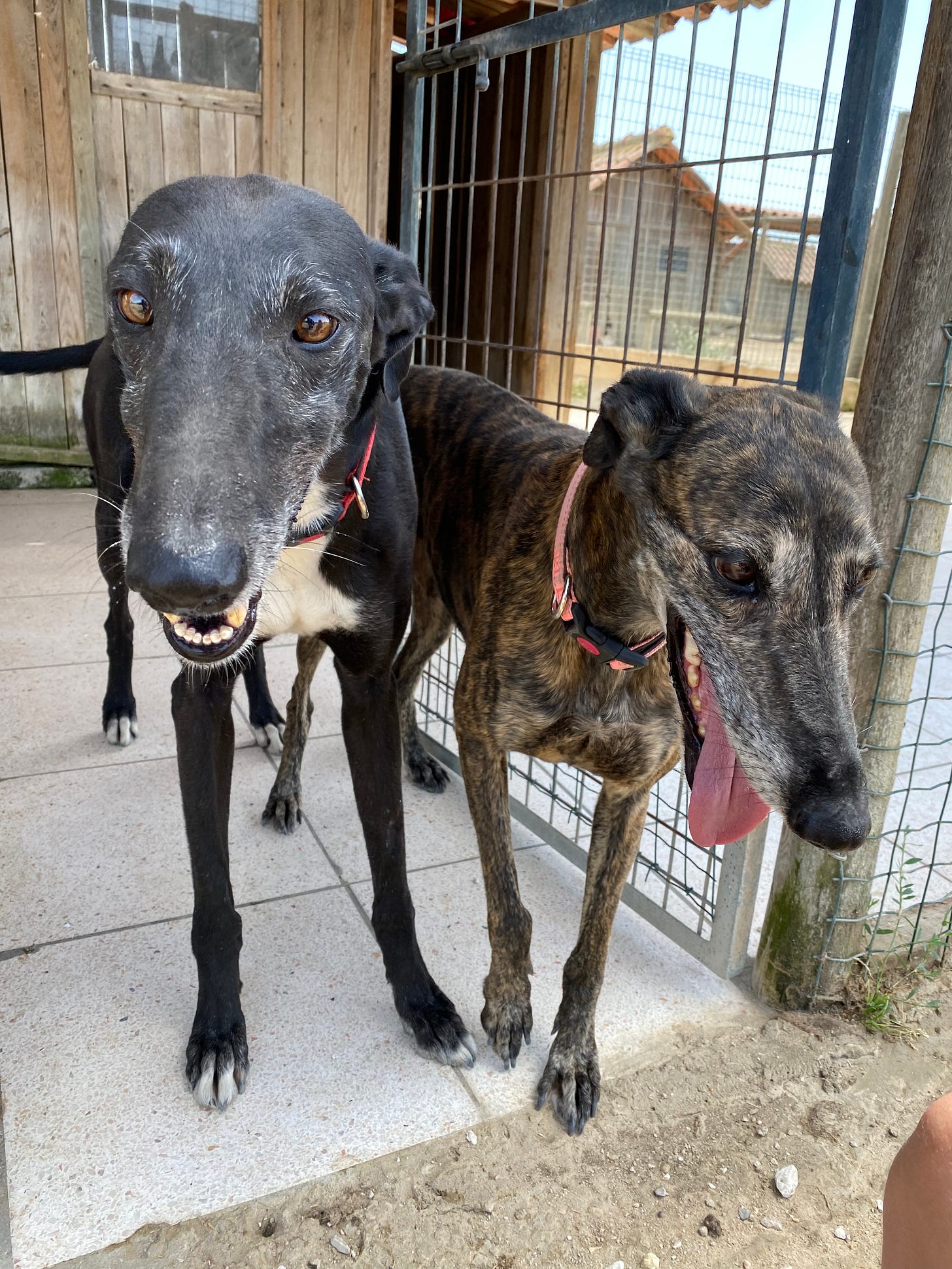
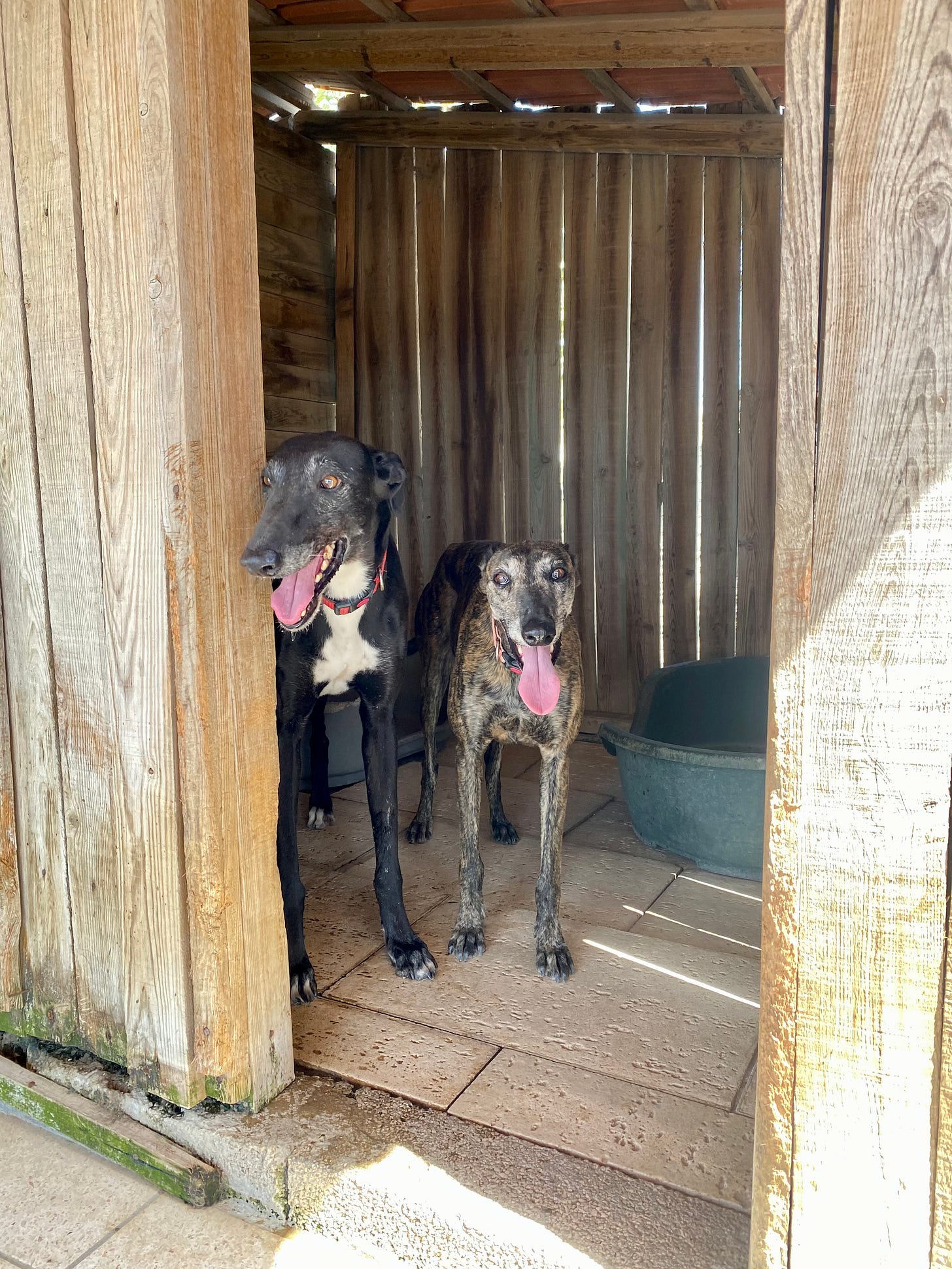
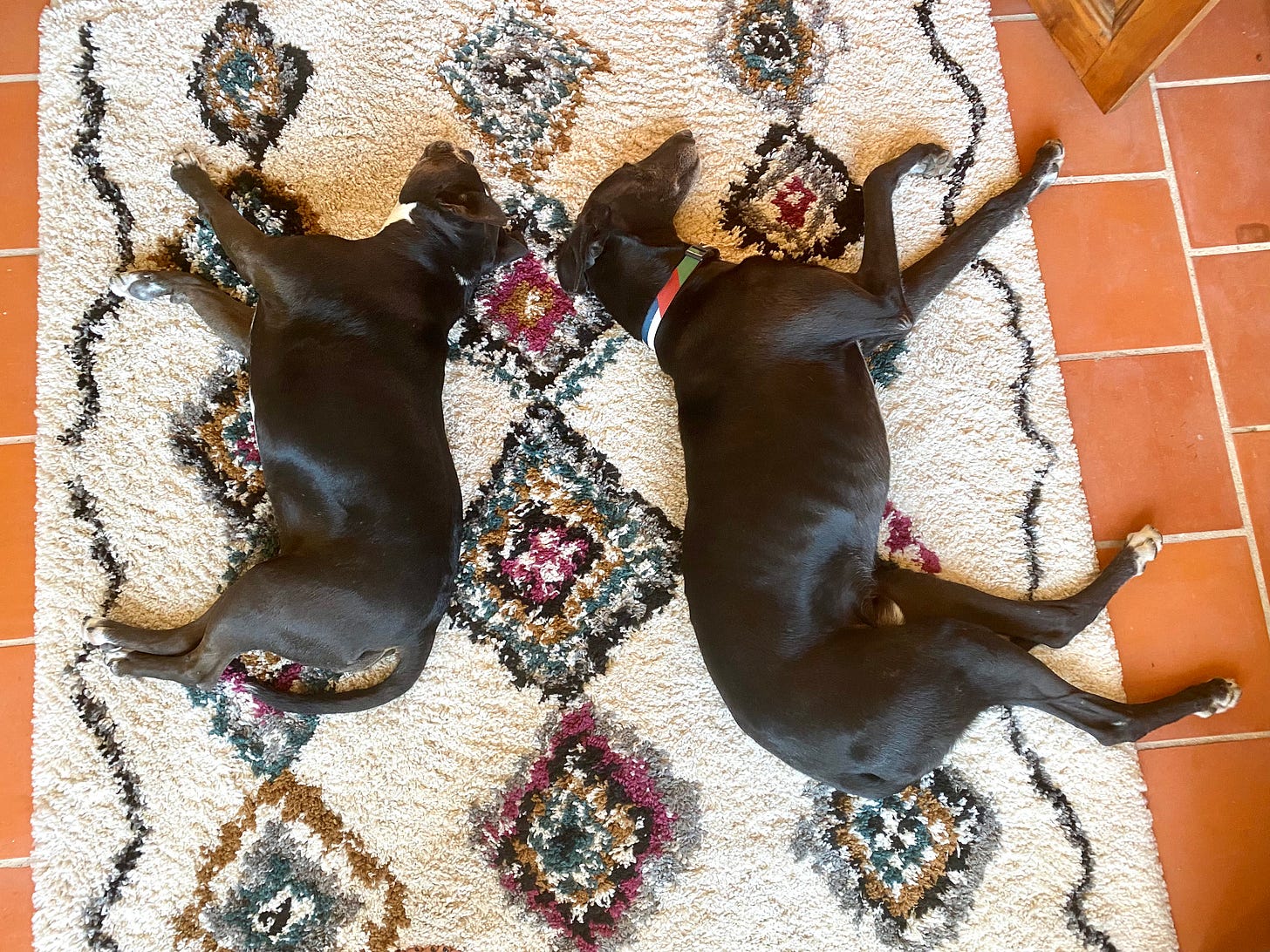

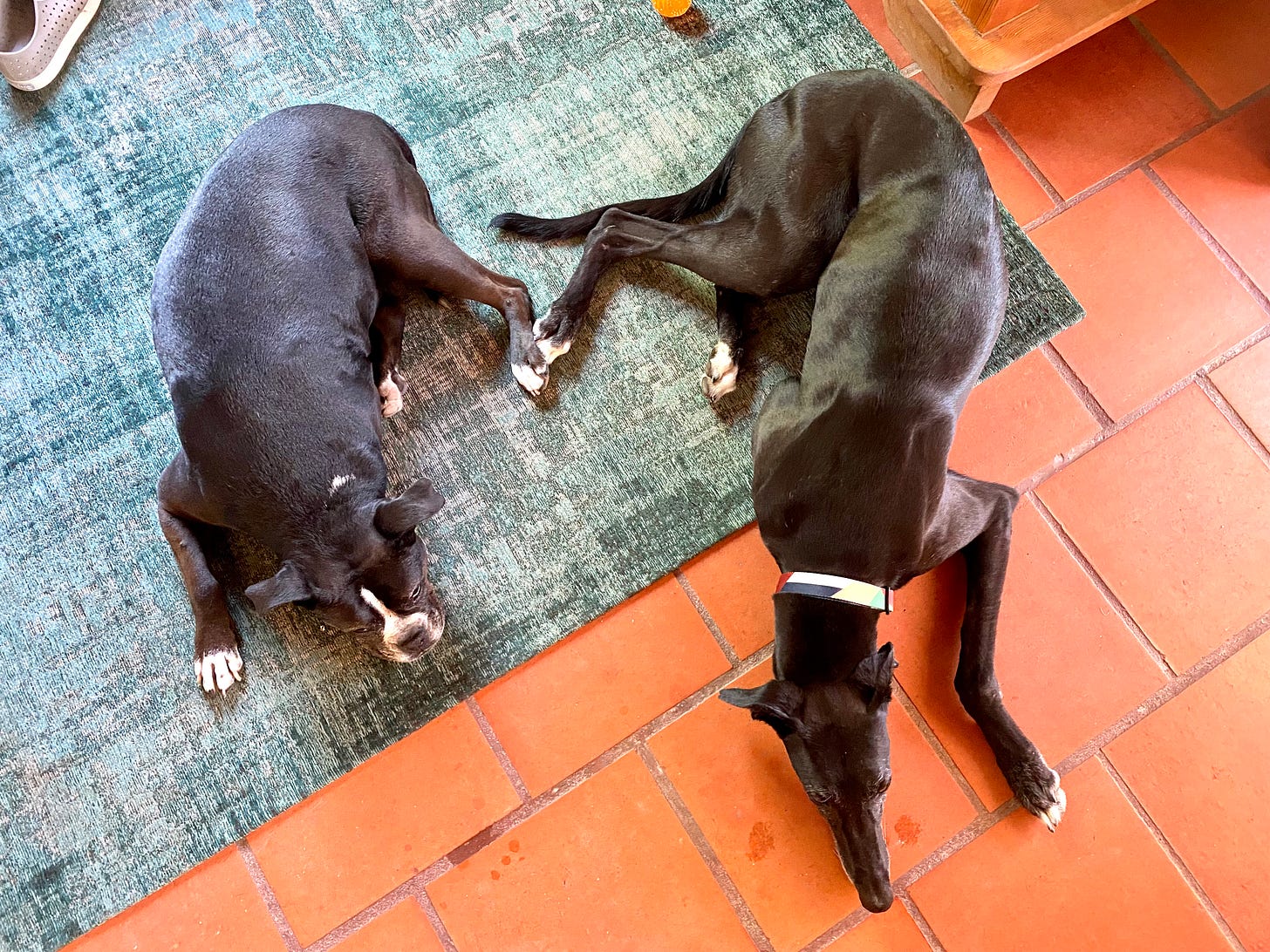
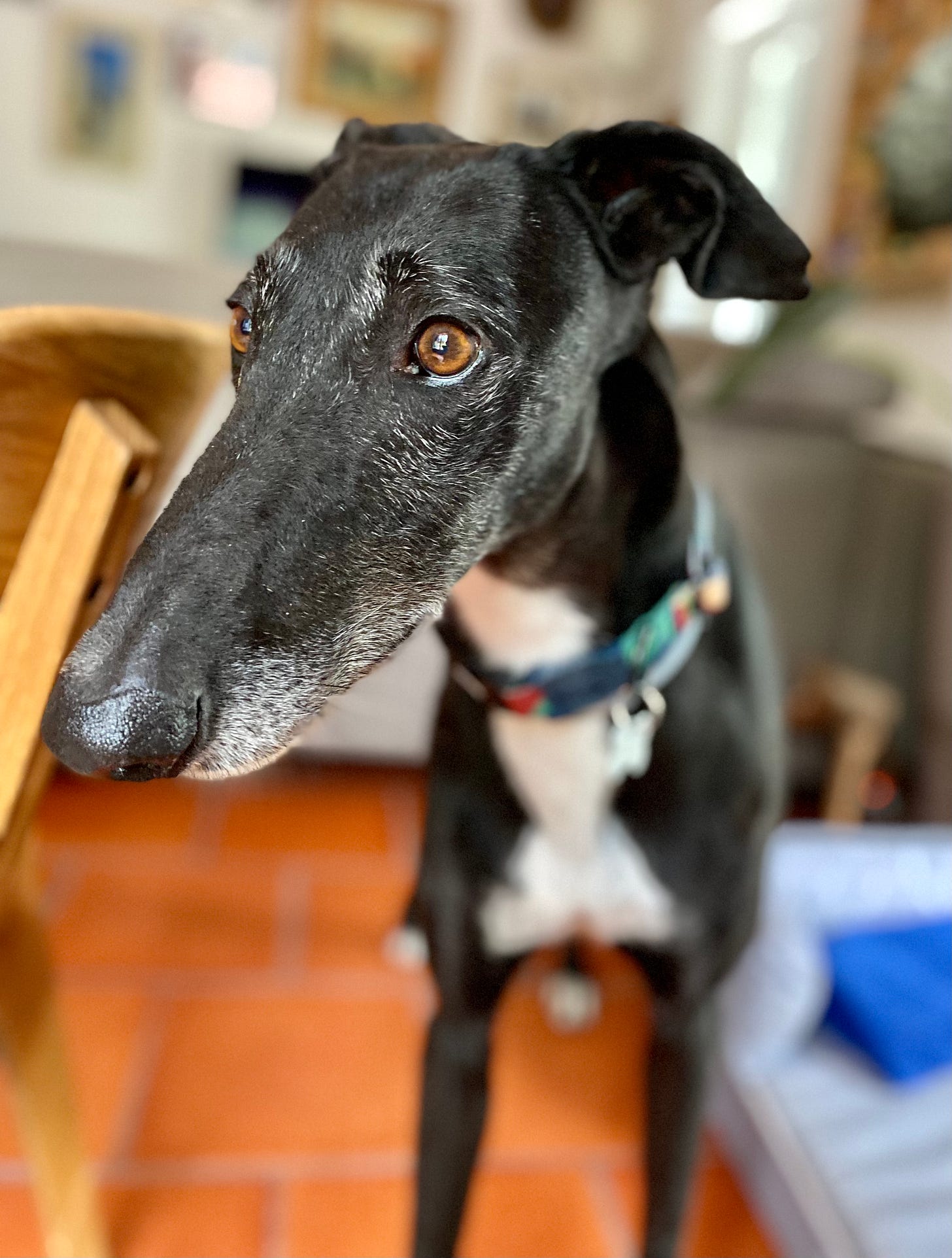
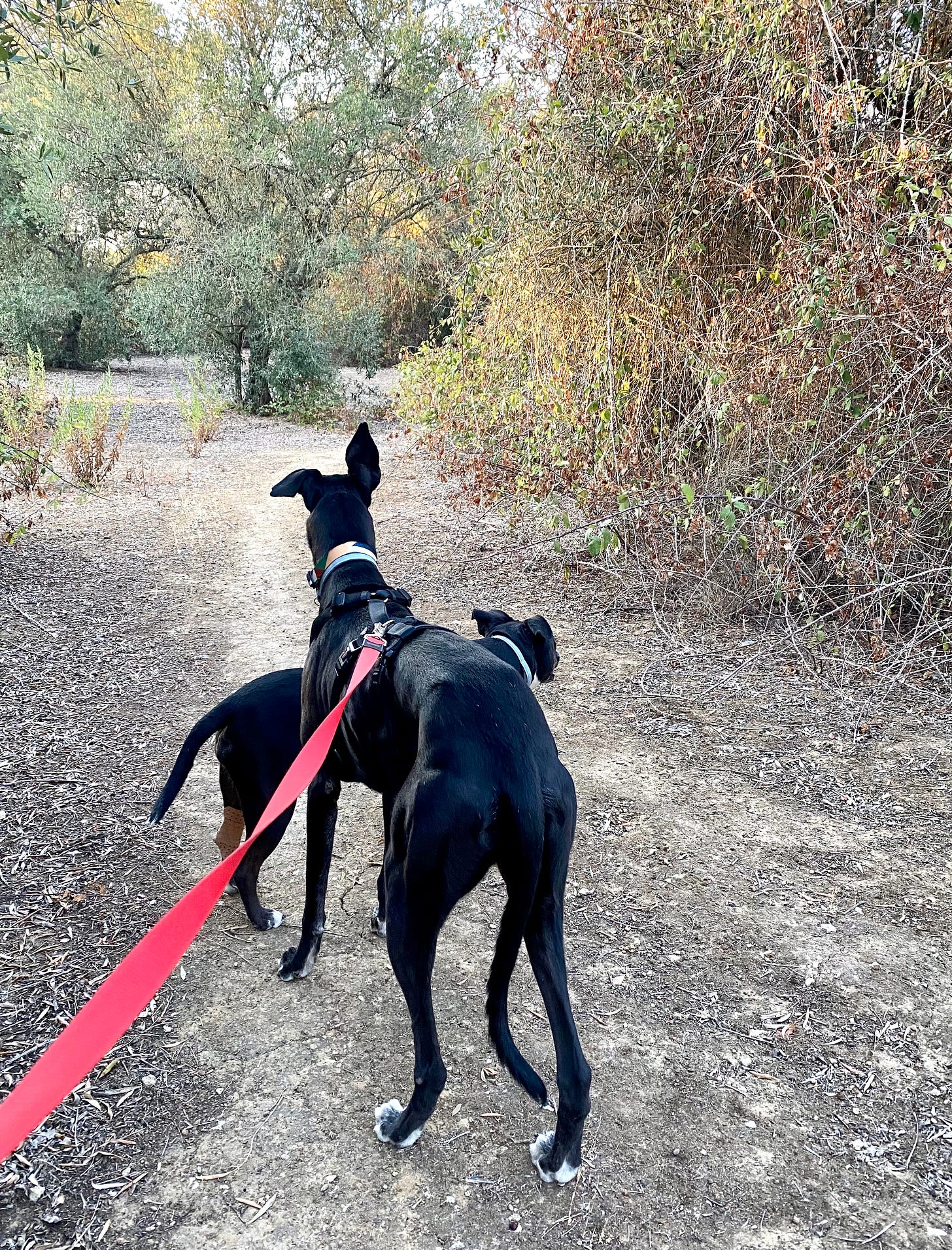
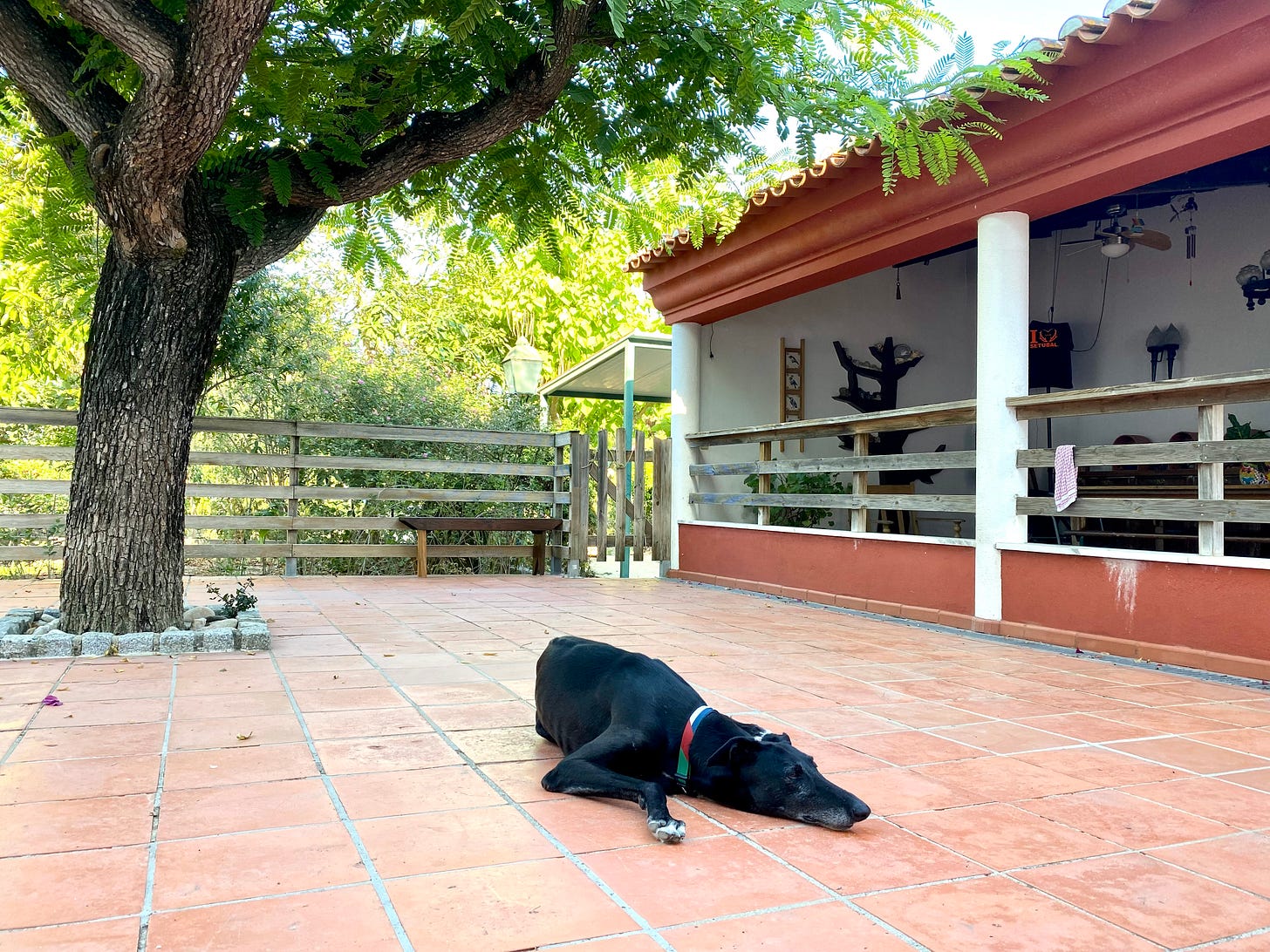
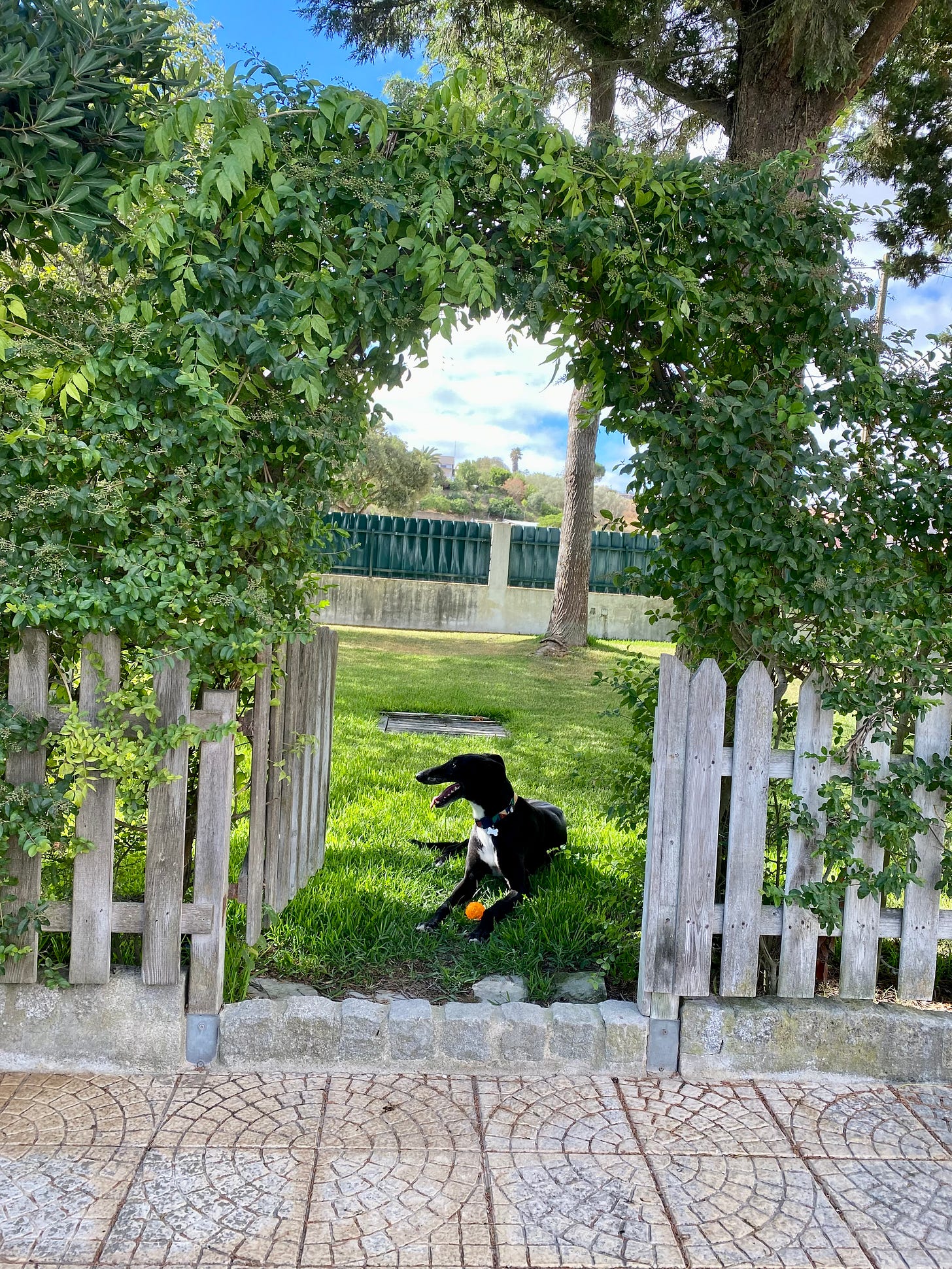
Thank you for such a positive way to start your day. Mary Oliver's poem How It is with us and How it is with Them came to mind.
“We meet wonderful people but lose them in our busyness. / We’re, as the saying goes, all over the place. / Steadfastness, it seems, / is more about dogs than about us. / One of the reasons we love them so much.”
Thank you so much for adopting this sweetheart, teaching us so much about the dog situations and rescues in Spain and Portugal, and for starting my day with a smile on my face looking at your two lucky doggies! I too have rescued a very unlikely pair. Archie is now a happy, goofy, lanky 45lbs poodle, and Héloïse a chunky Lhasa Apso mix that my husband originally called surly Shirley. 😉🐶